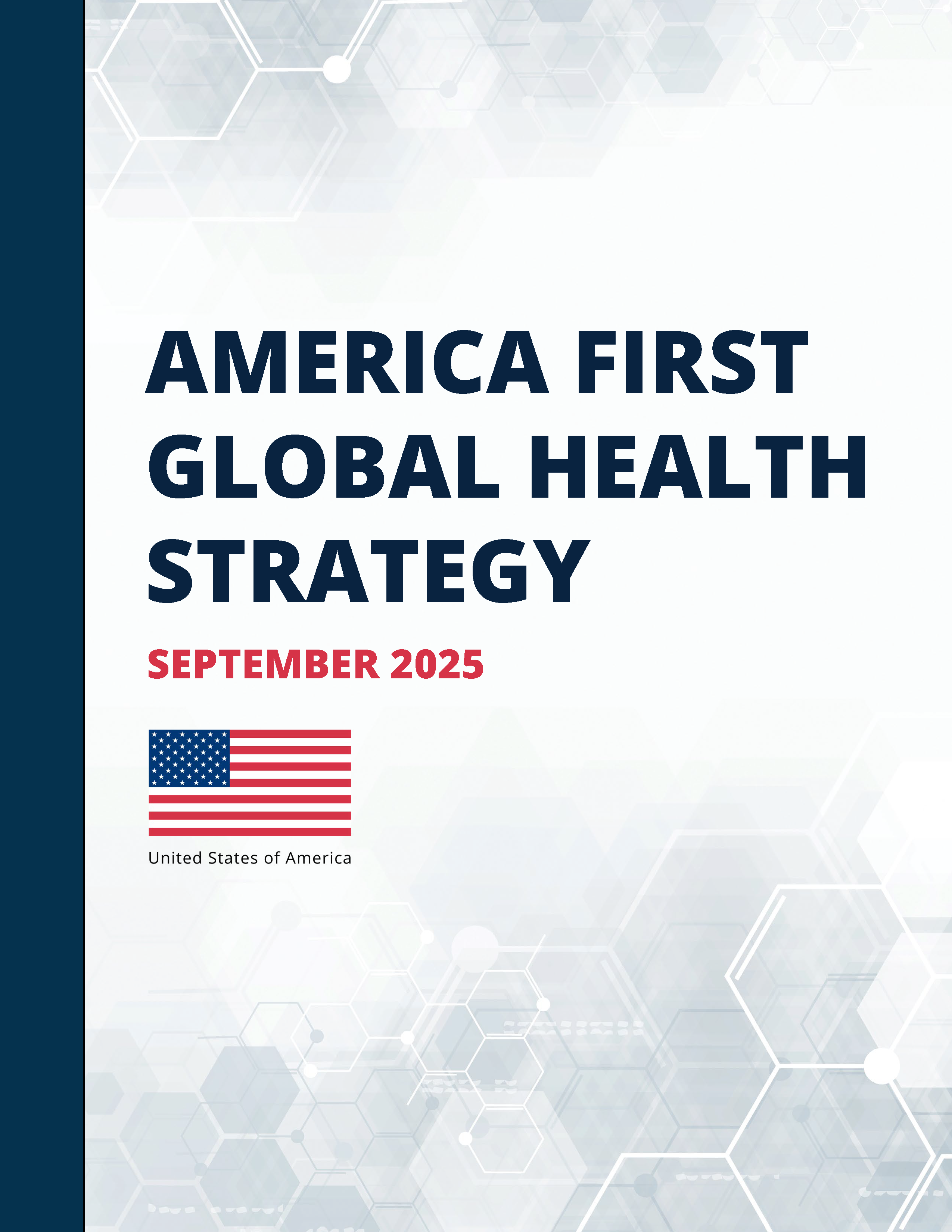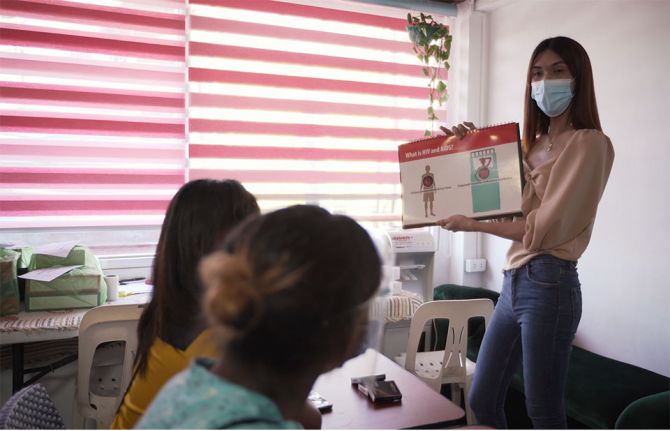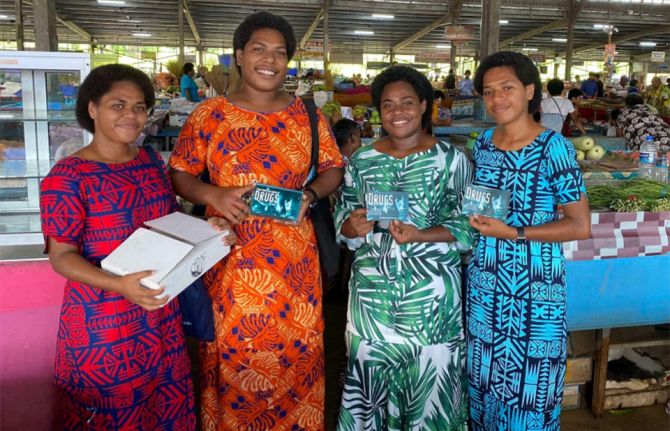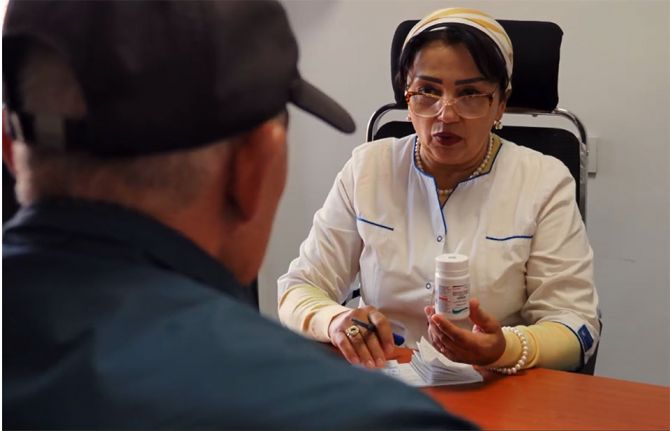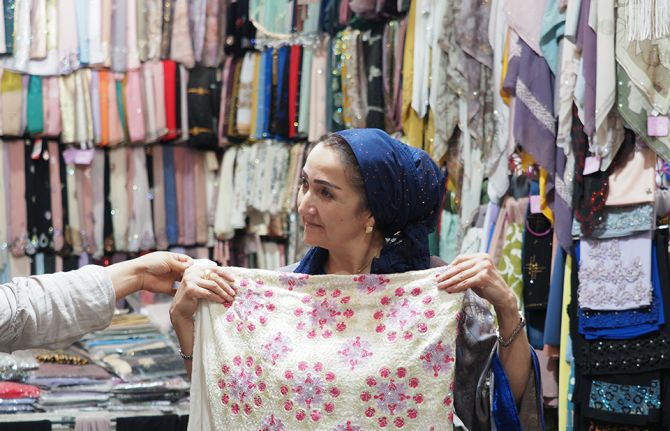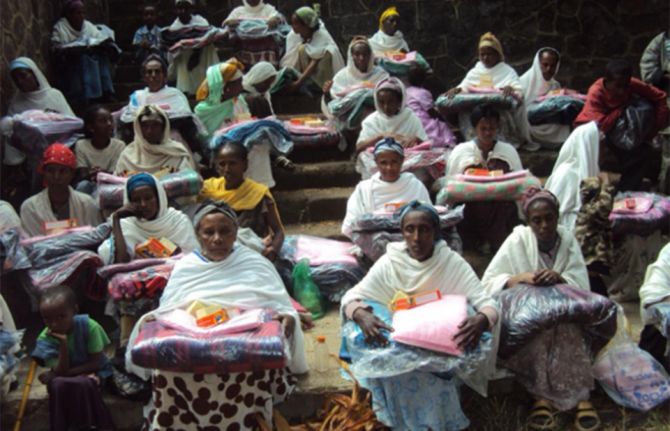
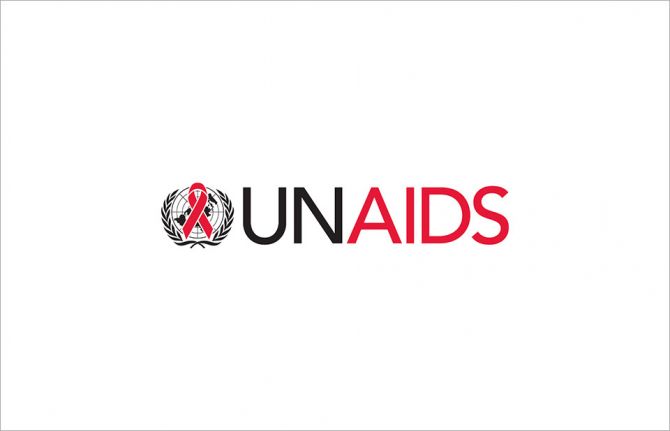
Press Release
UNAIDS is encouraged by the United States’ new strategy on global health and its strong commitment to continue to support people living with and affected by HIV
19 September 2025 19 September 2025The United States has launched a new ‘America First Global Health Strategy’ which sets out a new and tailored focus for PEPFAR, working closely with countries most affected by HIV
GENEVA, 18 September 2025—UNAIDS welcomes reaffirmed leadership from the United States in the AIDS response and its continued commitment to saving lives through the United States President's Emergency Plan For AIDS Relief (PEPFAR). In its new strategy, released today, the US is placing emphasis on global HIV targets, country partnerships and resilient and durable health systems. It stresses that national self-reliance is critical to achieving and sustaining the shared global objective of ending AIDS as a public health threat.
The new strategy highlights several of UNAIDS’ global HIV targets as key benchmarks for US foreign health assistance, including:
- Ensuring that 95% of people living with HIV are aware of their HIV status, 95% of those who know their status are receiving lifesaving HIV treatment, and 95% of those on treatment achieve viral suppression
- Achieving a 90% reduction in new HIV infections by 2030 (compared to 2010 levels)
- Achieving a 90% reduction in AIDS-related deaths by 2030 (compared to 2010 levels)
- Eliminating mother-to-child transmission of HIV in high-burden countries
This timely initiative underscores the continued support of the American people and the US Government in the historic effort to end AIDS—one of the greatest public health challenges of our time. By prioritizing results-driven targets like the UNAIDS 95-95-95 and 90% reduction in new infections by 2030, the US Government will help save millions more lives and accelerate progress to end AIDS.
UNAIDS remains firmly committed to advance and strengthen its long-standing, strategic partnership with the US Government and will continue to work hand-in-hand with PEPFAR to support countries to sustain durable, country-led HIV responses. UNAIDS will work closely together with the US Government in this historic effort to end AIDS—one that saves lives, strengthens global partnerships, makes the world safer and stronger, and brings us all closer to a world without AIDS.
UNAIDS
The Joint United Nations Programme on HIV/AIDS (UNAIDS) leads and inspires the world to achieve its shared vision of zero new HIV infections, zero discrimination and zero AIDS-related deaths. UNAIDS unites the efforts of 11 UN organizations—UNHCR, UNICEF, WFP, UNDP, UNFPA, UNODC, UN Women, ILO, UNESCO, WHO and the World Bank—and works closely with global and national partners towards ending the AIDS epidemic by 2030 as part of the Sustainable Development Goals. Learn more at unaids.org and connect with us on Facebook, Twitter, Instagram and YouTube.
Region/country

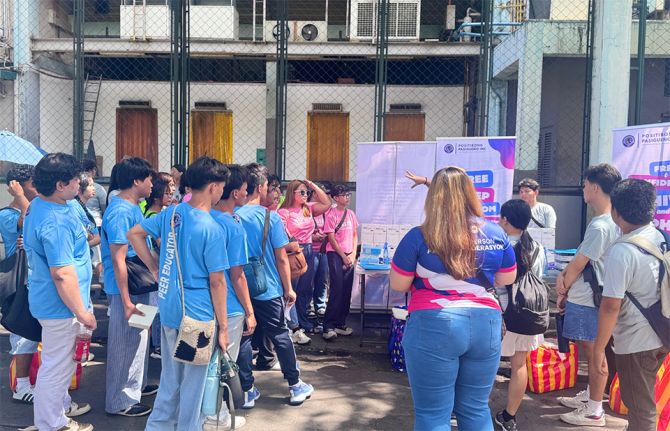
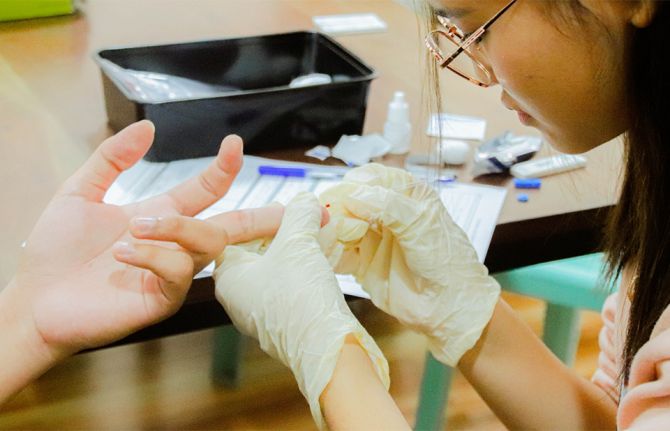
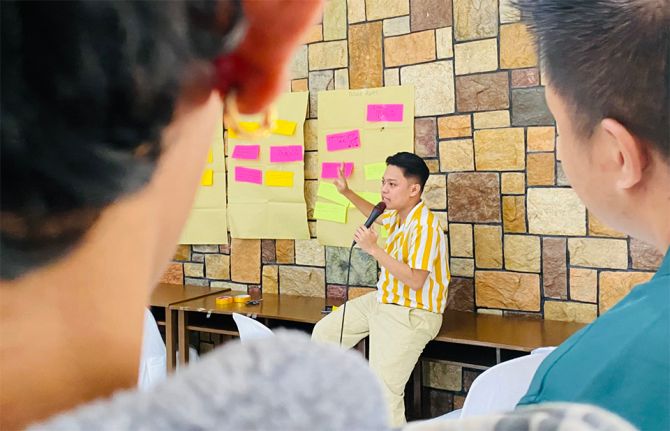
Feature Story
Funding cuts undermine community-led innovations in the Philippines
21 July 2025
21 July 2025 21 July 2025This story was first published in the UNAIDS Global AIDS Update 2025 report.
“We will focus on treatment!” This is the reassurance HIV advocates say they have received from the Government of the Philippines in the aftermath of United States funding cuts to the Philippines HIV response.
These commitments are critical to scale up treatment access for the 60% of people living with HIV in the Philippines who are not currently receiving antiretroviral therapy. But far more is needed to achieve epidemic control in a country that has seen a six-fold increase in new infections since 2010.
In 2024, three to four people were infected with HIV every hour in the Philippines. Of particular concern is that almost half of them are young people aged 15–24 years. Programmes to reach young key populations, especially young gay men and other men who have sex with men, are urgently needed.
“We are seeing a trend where younger and younger people are getting infected,” says Russell Elloso of Network Plus Philippines, the umbrella organization of people living with HIV. “And we are not seeing a plateau—the number of cases is still increasing. That means the current approaches are not working.”
Through PEPFAR, the United States invested primarily in supporting HIV prevention strategies and community-led work to ensure services reached people most in need.
One of the programmes that has been cancelled as a consequence of the funding cuts is the EpiC-supported Free to be YOUTH HUB. This innovative think tank developed culturally resonant HIV prevention and treatment support approaches specifically for young people. It ran 12 projects, including an academy for social media influencers, an innovative approach to HIV education, and a peer-led project to re-enrol youth who had stopped HIV treatment.
“We have a progressive HIV policy in the Philippines and a comprehensive sexual and reproductive health policy, but they are not youth-focused and youth centred,” explains Aaron James Villapando, Co-chair of Free to be YOUTH. “The value of this initiative was having an advisory board focused on promoting a youth-led response. Young people can lead, and we need to be at the frontlines of the HIV response for it to be effective.”
In the aftermath of the funding freeze, the organization has ramped up efforts to engage the private sector and foundations. A key priority has been to work with local government and local youth councils to secure more decentralized and sustainable funding for HIV programmes in the respective provinces. But activists are finding it particularly difficult to secure support for interventions for young key populations.
“Our Secretary of Health has assured the public that they will scale their current initiatives with a goal of not being so dependent on international funding. But the reality is that some of the community-led projects that are most needed are not priorities,” Mr Villapando says.
Stakeholders are lobbying the Department of Health to expand modern prevention methods and community-led service delivery, which were traditionally funded by external donors. These donor investments specifically addressed critical programmatic gaps, including youth programming and increasing access to modern testing and prevention options.
Despite the Government procuring almost all HIV commodities, including PrEP, challenges remain around funding and systems for community-led responses, and the introduction of novel interventions such as long-acting PrEP, the dapivirine vaginal ring and selftesting. Advocates are lobbying policy-makers to develop and implement a social contracting mechanism so the community can continue to provide services without support from the Global Fund to Fight AIDS, Tuberculosis and Malaria (Global Fund) and PEPFAR.
Global AIDS update 2025
Region/country
Related

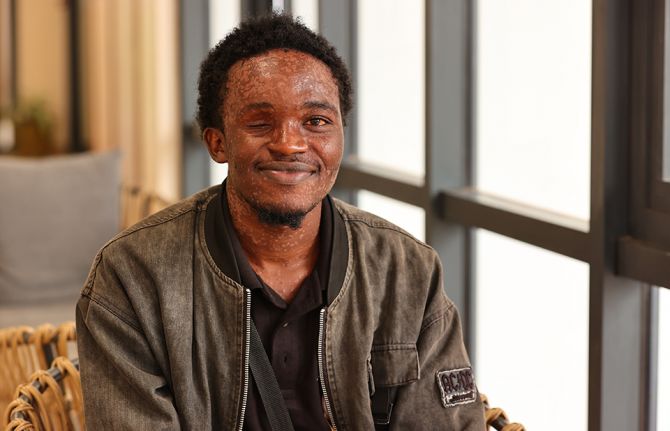
Feature Story
A lifeline interrupted in Uganda— why community health systems matter
18 July 2025
18 July 2025 18 July 2025This story was first published in the UNAIDS Global AIDS Update 2025 report.
In early 2025, 22-year-old Jokpee Emmanuel arrived at Reach Out Mbuya in Kampala, Uganda, expecting to attend the Friends Forum—a safe space for young people to gather, share and support each other. Instead, he was met with a sign on the gate: “Due to the suspension of United States funding, Reach Out Mbuya will be closed for 90 days. We regret the inconvenience caused.”
The Reach Out Mbuya community health initiative is not just a health facility. It is a lifeline. For years, it served Uganda’s most vulnerable communities, offering care that goes far beyond medicine. For Jokpee, who was born with HIV, Reach Out provided access to antiretroviral therapy, emotional support, school tuition and dignity. “Reach Out was like a second home,” he says. “They did not just give me medicines. They cared for me and reminded me that I am more than my diagnosis. I could live a full life.”
The closure followed a suspension of United States funding through PEPFAR, which had long supported community-led HIV responses in Uganda. The impact was immediate and severe. Community-led and community-based centres such as Reach Out Mbuya are central to public health in many low-resource settings. They offer holistic, personcentred services catered to local realities. They respond to the social, emotional and economic realities of people’s lives. These systems have been essential to the global HIV response, driving down infections and improving quality of services and life, especially among marginalized groups.
Jokpee was forced to seek care at an overcrowded Government facility. He waited six hours, only to be told antiretroviral medicines were out of stock and to return the following week. “A week without antiretroviral medicines! That is how resistance develops. That is how people die,” he says.
He eventually received a one-month supply of medicines, but the fear of another stockout remained. Although the Government of Uganda worked to fill the gap through national health facilities, it could not match the reach or personal connection of community-based programmes.
In the weeks that followed, Reach Out Mbuya managed to reopen, with support from a PEPFAR-funded programme called Kampala HIV Project. Most staff returned, restoring most of the centre’s core services. The number of clients accessing the centre is slowly increasing but is still below previous levels.
Jokpee’s story is a warning. When community-led and -based systems lose support, people fall through the cracks. If it were not for places like Reach Out Mbuya, Jokpee and his peers would be at risk of being left behind in the HIV response.
Sustained investment in community-led responses is the only way forward if we are to end AIDS as a public health threat by 2030.
Global AIDS update 2025
Region/country

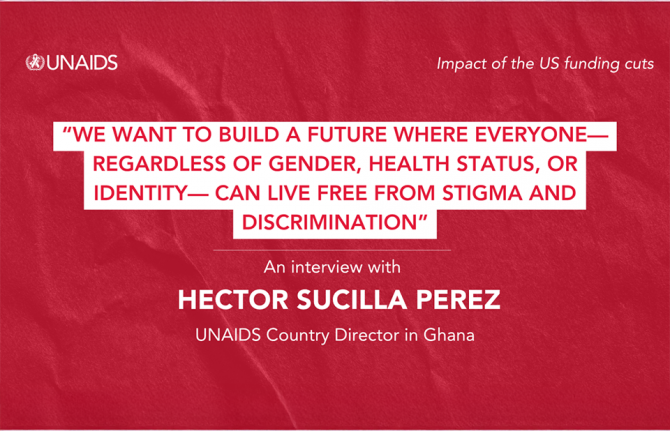
Feature Story
"We want to build a future where everyone—regardless of gender, health status, or identity—can live free from stigma and discrimination"
05 June 2025
05 June 2025 05 June 2025Ghana’s efforts to end AIDS has long relied on international support, particularly from the United States. Recent US funding cuts, however, have led to the suspension of critical programmes including human rights, raising concerns for key populations most affected by HIV-related stigma and discrimination.
In this interview, Hector Sucilla Perez, UNAIDS Country Director for Ghana, talks about the current state of the HIV response, the consequences of these funding changes, and the next steps for the country’s HIV response.
Q: What is the current state of Ghana’s HIV epidemic?
Ghana has an estimated 330 000 people living with HIV, with two-thirds being women aged 15 and over. In 2023 alone, there were 18 000 new infections and 12 000 AIDS-related deaths. The most affected groups are transgender women, men who have sex with men, female sex workers, and women. While new infections and deaths have decreased over the last decade, the reduction is far below expectations—only a 19% drop in new infections and 35% in deaths since 2010. The country needs to speed up more in the way we are decreasing new infections and deaths.
Ghana’s HIV response is heavily dependent on international donors. In 2022, Ghana's total expenditure on HIV and AIDS-related activities was approximately US$ 126 million. The Global Fund covers about 29% of this, PEPFAR (the US President’s Emergency Plan for AIDS Relief) about 8.5%, and the UN about 4.5%. PEPFAR support in Ghana has been essential and critical, investing more than US$ 204 million since 2007, mainly in HIV prevention, testing, treatment support, monitoring, and human rights work.
Q: What specific activities has PEPFAR been supporting in Ghana?
PEPFAR works in three regions of Ghana, (Western, Western North, and Ahafo), supporting essential catalytic services related to HIV prevention, including PrEP, as well as diagnosis, testing, treatment, and support services. They have also been supporting monitoring and evaluation to strengthen health information systems and improve data accuracy, which is critical for guiding our response.
Additionally, PEPFAR has been implementing human rights programmes with special emphasis on eliminating HIV-related stigma and discrimination. While they do not procure antiretroviral treatment in Ghana, they provide key technical assistance to the health sector on supply chain management for drugs and commodities.
Q: What has been the impact of the recent US funding cuts?
The initial pause in US government support affected activities in more than 120 healthcare sites across two regions, affecting 10 civil society organizations collaborating on PEPFAR-implemented programmes.
Some critical PEPFAR-supported actions were thereafter reinstated due to the waiver, particularly those related to the 95-95-95 targets, with a focus on vulnerable populations, especially adolescent girls and young women, and pregnant women. Monitoring, evaluation, data collection, and technical support for supply chain management were also reinstated.
However, strategic activities related to human rights with emphasis on stigma and discrimination, community-led monitoring, and interventions focusing on key populations have been definitively suspended. This represents a significant challenge for Ghana's HIV response.
Q: How is Ghana responding to these funding cuts, particularly regarding human rights programmes?
The government, through the Ghana AIDS Commission, has re-established and reinvigorated the Human Rights Stream Committee supported by UNAIDS and the Global Fund Grant. The Committee is currently to analyzing how the country can take over some of these activities. They are looking at integrating HIV more deeply into actions implemented by other government partners such as the Commission for Human Rights and Administrative Justice (CHRAJ), and increasing collaboration with the Ministry of Gender and Social Protection and the Ministry of Labour. UNAIDS provides technical assistance in support to these efforts.
We are also supporting CHRAJ to develop a handbook on stigma and discrimination through the lens of HIV, health and rights as a sustainable way of embedding continuous professional development in the work of this Government entity on actions focused to address HIV stigma and discrimination.
UNAIDS in Ghana is also strengthening community leadership particularly networks of PLHIV and key populations to play an important role in leading harmonized CLM initiatives in Ghana in collaboration with Global Fund implementers. This is by means of technical assistance and hands on support to communities to develop concrete priorities aligned to key data gaps, including stigma and discrimination and linkages to treatment adherence.
UNAIDS has also engaged with the Global Fund to explore using efficiencies in their grants to cover these activities. The Global Fund has shown willingness to potentially develop a strategy where all stakeholders can contribute to maintaining the most relevant human rights activities in Ghana.
Q: What new initiatives are being developed to address these gaps?
The UNAIDS country office is developing an umbrella strategy called the "Ghana for Rights Initiative." We envision this as a national movement aimed at promoting and protecting human rights in Ghana, especially for those most affected by inequality, discrimination, and stigma.
This initiative goes beyond the regular framework for HIV response, focusing more comprehensively on human rights issues such as gender equality, rights of persons in vulnerable situations, access to healthcare and education, and eradication of HIV-related stigma and discrimination.
The key components are advocacy, capacity building, and community engagement, with a strong emphasis on community-led monitoring. We are accelerating discussions with country partners, including the government, bilateral donors, communities, and the UN agencies to frame human rights in a different approach and mobilize resources for the country to continue priority work on HIV and human rights intersectional agenda.
Q: What are your concerns if human rights programmes remain suspended?
Without these critical human rights programmes, we risk seeing increased stigma and discrimination against people living with HIV and key populations. This could reverse progress made in encouraging people to get tested and access treatment, ultimately leading to more new infections and AIDS-related deaths.
The suspension of community-led monitoring also means we lose vital data and feedback from those most affected by HIV, making our response less effective and less targeted to real needs on the ground. This is why we are urgently working to find alternative approaches and funding sources to maintain these essential services.
Q: What is your message to the international community?
Now is not the time to step back from supporting the global HIV response. The progress we have made over the past years—reducing new infections, expanding access to treatment, and fighting stigma—has only been possible because of strong international solidarity and partnership. The recent US funding cuts have significantly impacted Ghana’s HIV programmes , especially those focused on human rights, stigma, and discrimination, which are essential to reaching the most marginalized and people in vulnerable situations .
We urge donors, development partners, and the global community to continue investing in the global HIV response especially in countries like Ghana, particularly in areas that protect and promote human rights. Without this support, we risk reversing decades of progress and leaving behind those who are most in need. Sustained international commitment is crucial to ensure that Ghana can achieve the UNAIDS 95-95-95 targets by 2030 and, ultimately, end AIDS as a public health threat.
We also invite all partners to join us in innovative approaches, such as the “Ghana for Rights Initiative,” to build a future where everyone—regardless of gender, status, or identity—can live free from stigma, discrimination, and the burden of HIV.
Watch: Disruption not the solution to end AIDS
Related resources
Region/country
Related

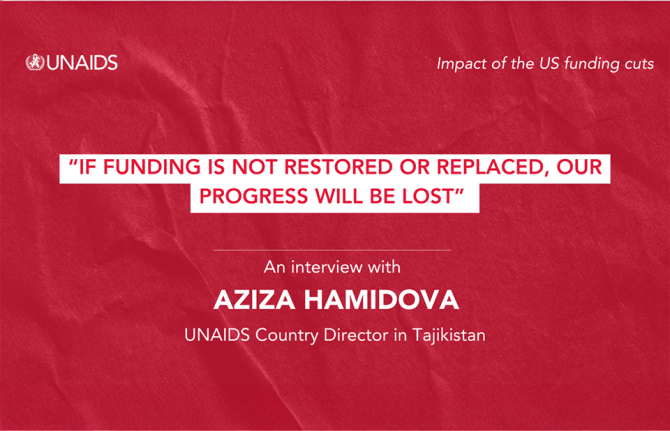
Feature Story
“If funding is not restored or replaced, our progress will be lost” - UNAIDS Country Director in Tajikistan amid funding cuts for the HIV response
29 May 2025
29 May 2025 29 May 2025As international funding declines, countries reliant on global support to fight HIV are being forced to adapt, and fast. In Tajikistan, the impact of these changes is already being felt. We spoke with Aziza Hamidova, UNAIDS Country Director in Tajikistan, about the country’s achievements over the years, the immediate impact of US funding cuts, and what is at stake for the most vulnerable communities.
Q: How would you describe the progress Tajikistan has made in its HIV response before the recent US funding cuts?
Tajikistan has made significant progress in its HIV response over recent years. Since 2020, HIV-related mortality has halved. Programmatic data on vertical transmission rates among women in care, suggests the rates have dropped from 2.6% in 2018 to just 0.8% in 2024, with only one case registered this year. Blood transfusion safety has been flawless for nearly 22 years, thanks to efforts by the Global Fund, UNAIDS, and other partners. Antiretroviral treatment costs have also been dramatically reduced—from US $254 to under US $65 per year—due to partnerships with PEPFAR, the Global Fund, and UNAIDS. Antiretroviral therapy is now available to all people living with HIV in the country. Outreach and awareness programmes, particularly for key populations such as people who inject drugs, men who have sex with men, sex workers, young people, and women living with HIV, have ensured good treatment coverage and testing rates. Pre-exposure prophylaxis (PrEP-medicine to prevent HIV) had also been available and promoted through civil society organizations. Importantly, community-led monitoring had become a critical, institutionalized part of the national HIV programme.
Q: What immediate impacts have the US funding cuts had on Tajikistan’s HIV response?
While the provision of basic HIV services, including testing and treatment at state healthcare facilities, has not been significantly affected—thanks mainly to Global Fund support—there have been notable reductions in outreach and access to services for key populations. PEPFAR’s investments have been crucial in improving the quality and reach of these services. As a result of the funding cuts, outreach, access to PrEP, testing, and counselling have all diminished. Two highly popular community health centres, known for providing stigma-free services, have closed, and community services for key population groups served by these centres have been completely stopped. Community-led monitoring, a vital mechanism for ensuring programme impact and accountability, has also been discontinued.
Q: What are you hearing from communities directly affected by these closures and service reductions?
Our partners and beneficiaries are reporting the suspension of awareness work, interruptions in comprehensive support programmes, and worsening mental health. We have observed a decreased adherence to antiretroviral therapy, particularly among clients who previously relied on community-led organizations or health centres. Many individuals who were on PrEP no longer feel safe or supported and have dropped out of the programme.
In addition, skilled professionals who provided these services have faced emotional burnout and job instability, with some leaving the sector altogether. Community-led organizations that lost funding for community-led monitoring are now unable to participate meaningfully in advocacy and policymaking or the implementation of the national HIV programme.
Although PEPFAR funding for community health centres and outreach was temporarily restored at the end of April, we are still seeing reduced rates of testing and client engagement, with a number of clients lost to follow-up.
Q: How have the government and partners responded to the funding cuts, and what is UNAIDS doing to support them?
Tajikistan never planned to remain dependent on external support indefinitely.
In 2024, with UNAIDS support, the country conducted a National AIDS Spending Assessment assessment, revealing that over 60% of the national HIV programme was funded externally, mainly by the Global Fund and the US government. In response, the government, with support from UNAIDS, PEPFAR, and the Global Fund, developed its first HIV Sustainability Roadmap, aiming for national programme sustainability by 2030. The abrupt funding interruption was a shock to all stakeholders, prompting emergency actions by the government. Strategic prioritization is now underway with the support of UNAIDS, and while additional state budget funding has been allocated for 2026, it remains insufficient. Mobilizing further external resources, especially for key populations, is still necessary.
Q: What would happen if US funding is not restored or replaced?
If US funding is not restored or replaced, Tajikistan would be set to lose about 60% of its HIV programme funding. This would risk the progress that we all worked so hard for, potentially returning the country to a time when access to testing and treatment was limited. Disruptions in prevention, testing, treatment, and care would occur, and gains achieved over years of dedicated work could quickly unravel. The most vulnerable populations would be at greatest risk, and the overall effectiveness of the national HIV response would be severely compromised.
Q: What message do you have for the international community?
The HIV response in Tajikistan, as in many countries, is a testament to the power of global solidarity and smart investments. Collective action by donors, governments, organizations, communities and civil society has saved millions of lives. Now, when we are so close to the 2030 goal of ending AIDS, this solidarity must not falter. Continued support is essential to preserve progress and prevent a reversal of the gains made.
The Joint United Nations Programme on HIV/AIDS (UNAIDS) leads the global effort to end AIDS as a public health threat by 2030 as part of the Sustainable Development Goals.
Following the US funding cuts in January, UNAIDS is working closely with governments and partners in affected countries to ensure that all people living with or affected by HIV continue to access life-saving services. For the latest updates, please visit unaids.org
Related resources
Watch: Humanity can do great things when united!
Watch: Funding cuts came as a complete shock, says Aziza Hamidova
Region/country

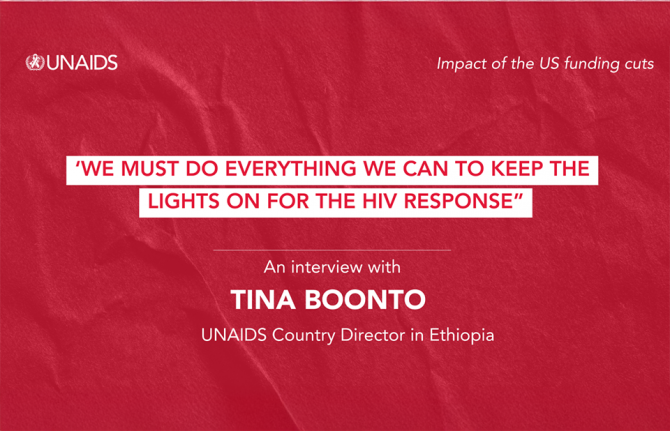
Feature Story
“We must do everything we can to keep the lights on for the HIV response” says UNAIDS Country Director for Ethiopia Tina Boonto
26 May 2025
26 May 2025 26 May 2025Ethiopia, with a population of 130 million, is Africa’s second most populous country. Despite steady economic growth approaching low-middle income status, the country faces a daunting number of challenges, from economic pressures and development needs to recurring natural disasters such as droughts and floods, as well as conflict and other man-made crises. These factors mean Ethiopia still relies heavily on external aid-particularly for food security and humanitarian assistance.
On top of these existing burdens, HIV remains a significant public health challenge. The country is home to an estimated 610 000 people living with HIV, with over half a million currently on life-saving antiretroviral treatment-most of which is funded by international donors. Recent cuts in US funding have put Ethiopia’s HIV response at risk, threatening to reverse years of progress and placing additional strain on an already fragile health system.
We sat down with Tina Boonto, UNAIDS Country Director for Ethiopia, to discuss the impact of the funding crisis, the government’s response, the resilience of communities, and what needs to happen next to protect Ethiopia’s HIV response.
Q: What is the current situation, and how has the recent US funding crisis impacted the HIV response?
Ethiopia has made significant progress in its HIV response in recent years and is on track to reach the UNAIDS 95-95-95 targets with 90% of people living with HIV in the country being aware of their HIV status; 94% of those diagnosed with HIV receiving antiretroviral (ARV) therapy; and 96% of people on ARV therapy achieving viral suppression. The US Government through PEPFAR and the Global Fund have been the primary funders for the HIV response, supporting treatment for over 530 000 of the estimated 600 000 people living with HIV in the country. However, the sudden cuts had a devastating impact. Critical services have stopped, people have lost their jobs, and many clinics have closed their doors. People living with HIV now face uncertainty about their access to medication, testing, and prevention services.
In Bahir Dar, for example, programmes for key population have stopped, outreach workers have lost their jobs, and peer support groups have been terminated. It’s heartbreaking to see the situation on the ground. Clients arrived at clinics to find them closed, and many were left without guidance or support.
Women are anxious about the availability of medication and prevention tools like condoms. Without these, the risk of HIV transmission increases, and the health of those already living with HIV deteriorates. Some cannot even afford basic necessities like food, let alone treatment.
Q: How are communities responding to the collapse of HIV services?
Despite the collapse, communities are showing incredible resilience and a fighting spirit. Peer educators, youth groups and mothers are stepping in where formal systems are failing. For example, in the Afar region, a case manager working with people living with HIV continued his outreach work despite funding cuts. He was able to get funding from the health bureau and shared “even if the money is not enough, I’m happy to continue to help reach people living with HIV, providing pregnant women information on how to prevent transmission to their babies”.
But while these community-led efforts are inspiring, they cannot replace the need for sustainable funding. Community members often live below adequate income levels, and they need support for basics like transport and food. UNAIDS is encouraging the government to consider a social contract with community organizations-similar to Ethiopia’s successful Health Extension Worker model-so that peer outreach workers can be formally supported and paid for their essential outreach work.
The reason why we are pushing for outreach workers to be supported is because stigma and discrimination remain significant barriers. Even after 40 years of the HIV epidemic, people living with HIV in Ethiopia still experience stigma, which deters them from seeking care at public facilities. Many fear being discriminated against or not receiving adequate services. This is why the role of community peer outreach is so vital. Without armies of community outreach workers, especially in high-burden areas, it’s impossible to have a successful HIV programme.
Q: What lessons can be drawn from this crisis for the future of HIV response in Ethiopia and beyond?
The crisis has exposed the fragility of systems built around a single funding stream. When the money stopped, so did services, trust, and hope. We must build resilience into the system from the start. Community-led organizations must be recognized as essential, and youth-led innovation must be scaled up. Emergency preparedness and integrated, people-centered solutions are crucial, especially as HIV intersects with conflict, displacement, and gender-based violence. HIV must remain central to humanitarian, development and recovery agendas-not as an afterthought, but as a foundation.
UNAIDS is also supporting by working on producing an investment case to prioritize key components of the HIV programme for government funding. There are ongoing discussions about new partnerships with the private sector and exploring alternative financing mechanisms. There is political will. The Ministry of Health is considering adopting the methodology of the HIV Sustainability Roadmap to develop a broader health sector sustainability strategy. UNAIDS is supporting these efforts by helping to produce a sustainability strategy and mobilizing resources alongside other donors
Q: What steps is the Ethiopian government taking to address the funding crisis?
The government recognizes this as a wake-up call and is actively considering solutions to find resources to cover priority health issues, including HIV, tuberculosis, and malaria. However, the scale of the challenge is enormous-external assistance for Ethiopia’s health, humanitarian and development needs amounts to around US$ 2.7 billion annually. The government is exploring options such as introducing a social tax, where all workers would contribute to health funding, but this is still under parliamentary discussion. While these efforts are encouraging, they are not yet sufficient to fill the gap left by international donors.
Q: How is UNAIDS supporting the government and the HIV response during this crisis?
UNAIDS is playing a critical role. In response to the funding crisis, we conducted immediate impact surveys to understand which programmes have stopped or are ongoing, and what the consequences are on the ground. This information feeds into the national plans and sustainability plan.
We are also producing an investment case to help the government prioritize key components of the HIV programme for domestic funding. Our costing data enables us to propose affordable models, like social contracting with community organizations.
We are reviving HIV prevention efforts, including using AI-powered digital platforms and chatbots to reach young people with real-time information. Ethiopia was also piloting long-acting injectable antiretroviral medicine to prevent HIV or ‘PrEP’ before the funding cuts stopped this progress.
Finally, we are working closely with the Ministry of Health, the Global Fund, and community organizations to mobilize resources and advocate for integrated, sustainable solutions.
Q: What is your message to the international community at this critical juncture?
We need global solidarity now more than ever. We are so close to ending AIDS as a public health threat by 2030. Over half a million people in Ethiopia are on antiretroviral treatment—we cannot let them down. The world has come too far, and too many have sacrificed too much to let progress slip away now. We must do everything possible to keep the lights on for the HIV response, both in Ethiopia and globally.
The resilience of Ethiopian communities is inspiring. People are refusing to give up, finding new ways to support each other and keep the response alive. With renewed commitment from the government, partners, and the international community, we can protect the progress made and continue moving towards ending AIDS as a public health threat.
The Joint United Nations Programme on HIV/AIDS (UNAIDS) leads the global effort to end AIDS as a public health threat by 2030 as part of the Sustainable Development Goals.
Following the US funding cuts in January, UNAIDS is working closely with governments and partners in affected countries to ensure that all people living with or affected by HIV continue to access life-saving services. For the latest updates, please visit unaids.org
Related resources
Watch: Tina Boonto, Ethiopia Country Director: Communities are going out of their way but they need help
Watch: UNAIDS asking government to increase domestic funding for the HIV response in Ethiopia
Watch: "We cannot let people down," says Tina Boonto, Country Director in Ethiopia
Region/country

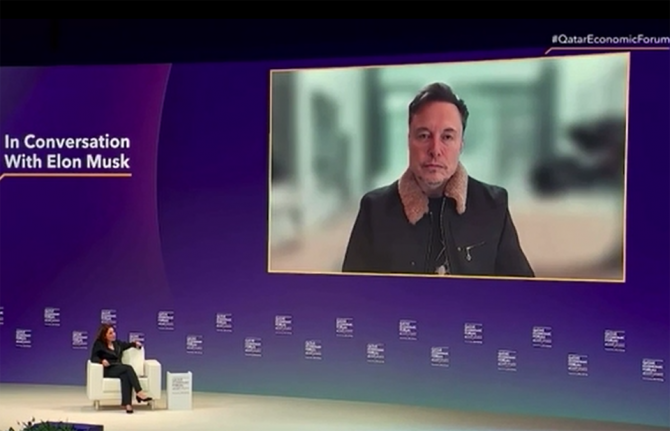
Press Release
UNAIDS encouraged by comments from Elon Musk that he will fix the US funding crisis for HIV services
21 May 2025 21 May 2025Mr Musk made the remarks during an interview with Bloomberg’s Mishal Husain at the Qatar Economic Forum on 20 May
GENEVA, 21 May 2025—UNAIDS is deeply encouraged by the statement from Elon Musk that he will fix the current crisis related to a lack of US Government funding for lifesaving HIV services. UNAIDS is tracking daily the impacts of US funding cuts on HIV services for people living with and affected by HIV around the world as the data and stories of impact on UNAIDS website show.
Currently, many HIV prevention programs supported by the US President's Emergency Plan for AIDS Relief (PEPFAR) have been stalled. The Administration issued a limited waiver providing for continuity of some services, including comprehensive HIV testing and treatment, but it is not being fully implemented within countries, and the waiver excludes almost all HIV prevention services except those for pregnant and breastfeeding women.
For detailed, specific examples of the impact of US funding cuts in dozens of countries see here: Impact of US funding cuts on the global HIV response | UNAIDS
UNAIDS estimates indicate that the permanent discontinuation of HIV prevention and treatment programmes currently supported by PEPFAR would, between 2025 and 2029, lead to:
- An additional 6.6 million new HIV Infections.
- Around 2300 additional new HIV infections per day.
- An additional 4.2 million AIDS-related deaths.
- Over 600 additional AIDS-related deaths per day.
Estimating the potential impact of HIV response disruptions
We can end the AIDS pandemic, but we cannot do so without continued partnership and leadership by the US on HIV prevention efforts for those most in need. Latest estimates show that 1.3 million people were newly infected with HIV in 2023; many were among the most marginalized and vulnerable groups, including young women and girls. Every week some 4000 young women and girls became infected in 2023.
Some countries relied on PEPFAR for over 95% of their funding for HIV and while UNAIDS has been supporting countries' transition to self-reliant nationally funded responses, this transition must be done methodically to ensure no more lives are lost during this process.
UNAIDS has also been impacted by US funding cuts; given the critical roles UNAIDS is playing to build a sustainable future for the AIDS response, the cuts undermine continued progress to end AIDS and transition to sustainability nationally owned and financed HIV responses.
UNAIDS is encouraged by Mr Musk’s remarks and urges the US to continue their leading role in ending AIDS by restoring HIV prevention and treatment funding to countries most affected by HIV. UNAIDS stands ready to work hand in hand with the US to help support sustainable transitions in the coming months and into the future.
Watch original interview:
UNAIDS
The Joint United Nations Programme on HIV/AIDS (UNAIDS) leads and inspires the world to achieve its shared vision of zero new HIV infections, zero discrimination and zero AIDS-related deaths. UNAIDS unites the efforts of 11 UN organizations—UNHCR, UNICEF, WFP, UNDP, UNFPA, UNODC, UN Women, ILO, UNESCO, WHO and the World Bank—and works closely with global and national partners towards ending the AIDS epidemic by 2030 as part of the Sustainable Development Goals. Learn more at unaids.org and connect with us on Facebook, Twitter, Instagram and YouTube.

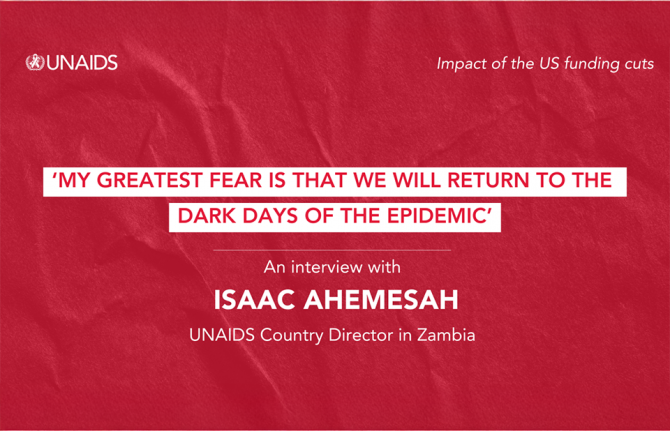
Feature Story
‘My greatest fear is that we will return to the dark days of the epidemic’
21 May 2025
21 May 2025 21 May 2025UNAIDS Country Director reports on the impact of funding cuts to the HIV response
The HIV response in Zambia, known as a model of success in sub-Saharan Africa, is now facing major challenges following the abrupt and significant cuts to US funding. It has led to widespread disruption: clinics have closed, prevention services have been scaled back, and thousands have lost access to lifesaving medication. Yet the Zambian government and partners are stepping in to protect the progress made.
In this interview, UNAIDS Country Director for Zambia, Isaac Ahemesah, details the fallout from these funding decisions on health services, vulnerable communities, and the country’s ability to sustain progress against HIV-and outlines what is urgently needed to avert further health crisis.
“In 1997, life expectancy in Zambia was about 46 years due to HIV and AIDS. In 2023, it was nearly 66 years because of the investments made and the strong partnership.”
Q: How have the US funding cuts impacted the HIV response in Zambia?
Zambia has long relied on international aid, including substantial support from PEPFAR. Three years ago, the US government’s commitment stood at approximately US$ 402 million, which was subsequently reduced to US$ 392 million, and most recently to US$ 367 million. Despite these reductions, the contribution remains significant, not only to the HIV response, but to Zambia’s overall health sector. To put it in perspective, of the US$ 600 million in total US support to Zambia for development last year, US$ 367 million, around 60%, was allocated to HIV.
However, the abrupt funding cuts led to the termination of key programmes. More than 11 000 health workers supporting the HIV response, and approximately 23 000 health workers providing services for malaria, tuberculosis, and other health needs, were impacted.
Several essential initiatives were stopped. These include the closure of 32 wellness centres that served over 20 000 key populations, including LGBTQ+ people, sex workers, and people who inject drugs, across seven of Zambia’s ten provinces. These centres offered critical services such as HIV testing, treatment, and support.
All DREAMS programmes, which supported adolescent girls and young women in 22 districts, have also been shut down. This has cut off access to HIV prevention, life skills, and economic empowerment activities for thousands of vulnerable girls.
HIV prevention services have also been disrupted. Sixteen standalone centres providing voluntary medical male circumcision - a proven HIV prevention method - have ceased operations. Nearly half of Zambia’s pre-exposure prophylaxis (PrEP) services, which help prevent HIV infection, were funded by the US and have now been discontinued.
Community-led monitoring programmes, which ensured quality and accountability in HIV care, have also been terminated. Furthermore, the Smart Health electronic medical records system, along with platforms used for forecasting and quantifying medical supplies, is no longer operational, making it increasingly difficult to manage patient care and maintain drug inventories.
Q: What will happen if the DREAMS programme is not reinstated?
Currently, Zambia records approximately 23 000 new HIV infections annually, with about 8700 occurring among young people aged 15 to 24. Notably, 60% of infections in this age group happen among girls.Without support for prevention and treatment interventions, new HIV infections could surge to 180 000 per year by 2030. Among young people, infections could rise to over 60 000 annually by 2030.
Gender-Based Violence (GBV) remains a growing concern in Zambia, and each GBV case carries a heightened risk of HIV transmission. Addressing this requires a coordinated, multi-sectoral approach that extends beyond HIV alone to include family planning and reproductive health services. National partners are working to reinvigorate this multi-sectoral response so that all relevant sectors-education, gender, internal affairs, and others-actively share responsibility for the HIV response.
Given the challenges, there is a pressing need to pursue local initiatives and mobilize alternative funding sources to support adolescent girls and young women, safeguarding their health and rights.
Q: Are there concerns about supplies of HIV medicines?
Yes, there is significant concern. At present, Zambia has sufficient antiretroviral (ARV) medication to last until the end of the year. However, the US has announced an additional US$50 million cut in funding for medicines and health commodities, effective from next year, due to concerns about drug theft. This will make it extremely difficult to ensure an uninterrupted supply of ARVs, particularly for the most vulnerable populations. There have already been reports of people living with HIV receiving reduced quantities of medication - less than the standard three- to six-month supply - due to ongoing uncertainty and challenges in stock management.
Q: What is UNAIDS doing to support Zambia during this crisis?
At the onset of the US funding freeze, UNAIDS immediately partnered with the Ministry of Health to convene national leadership and all key stakeholders. This was critical to coordinate a unified and effective response to the sudden disruption. We quickly led an impact assessment to understand how the freeze was affecting Zambia’s HIV response on the ground. This provided the data needed to guide urgent decisions.
One of our first steps was to work with the government and partners, we helped define a minimum package of essential HIV services that could realistically be maintained with the reduced resources available. We costed this package at about US$ 147 million and presented it to the Cabinet and Presidency for consideration in the national budget.
At the same time, we supported the development of the HIV Sustainability Roadmap, which explores alternative domestic financing options. This includes innovative approaches such as leveraging health insurance schemes and introducing total market strategies-for example, making PrEP and vaginal rings available through pharmacies.
We also worked closely with the Ministry of Health to revise policies to better fit the current context. For example, we supported allowing longer antiretroviral therapy refills—for up to six months–—to reduce the burden on both patients and the health system. We also helped adjust HIV testing protocols to manage limited supplies more effectively and piloted new service delivery models outside traditional health facilities to expand access.
At the operational level, we partnered with WHO, UNICEF, UNFPA, and others to monitor weekly stock levels of HIV commodities, ensuring timely responses to shortages. We support civil society organizations, especially those representing key populations, in transitioning clients from closed wellness centers to public health facilities, helping maintain continuity of care.
To address broader systemic challenges, UNAIDS contributed to the restructuring plan for the Zambia Medicines and Medical Supplies Agency to improve accountability and strengthen the supply chain.
Our Resource Allocation Forecasting Tool was used to estimate the real cost of sustaining Zambia’s HIV response, which we estimated at around US$ 150 million annually. This tool helps the government and partners plan budgets more effectively.
UNAIDS acts as the central hub for information-sharing and advocacy around the impact of US funding cuts. We regularly present needs assessments to the UN Country Team and support ongoing fundraising discussions to urgently mobilize resources to sustain services.
Finally, we have supported training for health workers to promote respectful, non-discriminatory care for key populations now accessing mainstream health services. This is vital to ensure no one is left behind despite the challenges.
Q: What is the solution to ensure sustainable financing for Zambia’s HIV response, and avoid such a crisis in the future?
The key to sustainable financing lies in increasing domestic funding and reducing reliance on external donors. While the recent US funding cuts were abrupt and challenging, this situation was not entirely unexpected. For years, Zambia and other countries have been encouraged to take greater ownership of their HIV responses. The real surprise was the speed and scale of the funding reductions.
To protect its HIV response, Zambia must now mobilize domestic resources. This includes engaging local philanthropic organizations, expanding the role of national health insurance schemes, and ensuring that HIV services are fully integrated within these systems. Innovative models like risk pooling and market-based access to prevention tools, such as making PrEP and vaginal rings available through pharmacies, will also be key to expanding reach and ensuring continuity.
On the global level, the HIV response must increasingly pivot toward long-acting treatment and prevention options, such as injectable PrEP and antiretroviral treatment. These innovations can help simplify adherence and improve outcomes.
Zambia is also exploring total market approaches, where the private sector helps supply prevention and treatment services. In addition, local production of ARVs could help reduce costs and improve supply chain stability.
Critically, the country has already shown that essential HIV services can be maintained on smaller budgets, provided resources are used efficiently. But for long-term sustainability, the government must take the lead. This means prioritizing HIV in the national budget and exploring innovative domestic revenue sources, such as earmarked taxes on alcohol, tobacco, or health products.
While international partners will remain important, the responsibility for a predictable, sustainable HIV response now rests squarely with Zambia itself—to protect the lives and health of its 1.4 million citizens living with HIV, and to ensure that no one is left behind.
Q: What’s your message to the international community?
Today, I believe the global HIV response stands at a crossroads. The decisions we make now will either help the world achieve Sustainable Development Goal 3.3—the target of ending AIDS as a public health threat by 2030—or risk a devastating reversal.
If we ease up, we could see a return to the 1990s, when new HIV infections spiraled out of control, HIV-related deaths surged, and the global economy suffered greatly.
All we ask for is a final push— a sustained commitment to support countries in fulfilling their promises to end AIDS as a public health threat. I urge the US government and all other donors to reconsider the recent funding cuts. We need to keep our foot firmly on the accelerator until we reach the finish line.
Otherwise, my greatest fear is that we will return to the dark days of the epidemic, with significant increases in new infections and deaths.
The Joint United Nations Programme on HIV/AIDS (UNAIDS) leads the global effort to end AIDS as a public health threat by 2030 as part of the Sustainable Development Goals.
Following the US funding cuts in January, UNAIDS is working closely with governments and partners in affected countries to ensure that all people living with or affected by HIV continue to access life-saving services. For the latest updates, please visit unaids.org
Related resources
Watch: Integration of HIV services key
Watch: Final push needed
Region/country

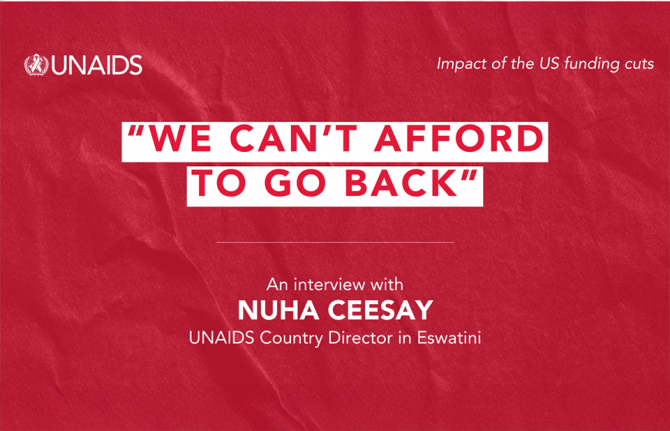
Feature Story
‘We Can’t Afford to Go Back’- UNAIDS Country Director on HIV funding cut in Eswatini
14 May 2025
14 May 2025 14 May 2025Eswatini, a country once described as the epicentre of the HIV epidemic with nearly 1 in 3 adults living with HIV in 2015 [adult HIV prevalence in 2015 was 31%]. But Eswatini managed to turn around its HIV epidemic, reducing new HIV infections from a peak of 21 000 per year in 2000 to 4 000 in 2023, a remarkable result, achieved with the support of US funding.
However, the sudden US funding cuts threaten to undo years of progress. We sat down with Nuha Ceesay, UNAIDS Country Director in Eswatini, to discuss the current situation, the impact on HIV services, and the way forward.
Q: How are US funding cuts impacting Eswatini’s HIV response?
Eswatini’s HIV response has been a success story, by transforming a crisis that once saw extremely high HIV prevalence rates, into a model of resilience and opportunity. But the recent US funding cuts, representing about half of the country’s HIV response budget, have left the people living with and affected by HIV in despair, the government was not notified and left unprepared, and the people working to end AIDS are in total shock. There is real concern that new HIV infections and AIDS-related deaths will rise, reversing years of hard-won progress. The cuts threaten not just HIV treatment and prevention, but also the broader health system improvements, data collection, jobs and empowerment of people living with HIV.
Q: What disruptions are being seen on the ground?
The effects are immediate and widespread. HIV testing services, the gateway to treatment, are now limited. With fewer people being tested, many may unknowingly be infected with HIV, missing the chance for early treatment and increasing the risk of further transmission. This could push annual new infections, which are currently around 4 000, even higher, and add pressure to already strained treatment resources. Stockouts of antiretroviral, lab test kits, and condoms are expected within months, and health worker layoffs are affecting service delivery and quality data collection. Primary prevention services, such as medicine to prevent HIV (PrEP), education campaigns, and voluntary medical male circumcision for HIV prevention (which is around 60% effective in preventing HIV) have also been scaled back or suspended.
We are also seeing a stop of the DREAMS programme which is a major setback for adolescent girls and young women, who are disproportionately affected by HIV in Eswatini. DREAMS provided prevention education, skills, and socio-economic support to young women. Its termination leaves them more vulnerable to infection and strips away resources that have been central to empowering this high-risk group. HIV prevalence among young women and girls aged between 15 and 24 years was 70% higher than among young men in Eswatini in 2023.
Read more about the impact on UNAIDS website
Q: How is UNAIDS responding to these challenges?
UNAIDS is working closely with the government and partners to continue the work of developing and implementing the HIV Sustainability Roadmap. This will help Eswatini’s HIV response to gradually shift from being reliant on international aid to increasing its domestic funding which will lead to the government taking full ownership of its HIV response. The first phase of this roadmap has already been launched, focusing on building resilience and long-term solutions.
UNAIDS has also worked closely with the Ministry of Health and partners to map the impact of the funding cuts, identify service gaps, and strategize on mitigating disruptions. Collaboration with the Ministry of Health, UN partners, and civil society remains central, but the transition to sustainability is a complex and gradual process.
Q: What’s your message to the international community?
The successes that we celebrate in the HIV response are built on mutual accountability and global solidarity. That’s what enabled countries like Eswatini to shift the narrative-from a crisis by leading a response that brought down new HIV infection to 4 000 compared to when new infections were as high as 21 000.
It is therefore devastating to see all the hard-won gains being reversed at this stage. This is the moment we need to come together in solidarity and in partnership to accelerate our collective efforts.
Ending the epidemic is like a marathon. We have run the race many miles, but the end is what matters. If we cannot reach that finish line, it means we have not completed, and we cannot afford that.
The Joint United Nations Programme on HIV/AIDS (UNAIDS) leads the global effort to end AIDS as a public health threat by 2030 as part of the Sustainable Development Goals.
Following the US stop work order in January, UNAIDS is working closely with governments and partners in affected countries to ensure that all people living with or affected by HIV continue to access life-saving services.
For the latest updates, please visit unaids.org
Related resources
Watch: "Access to prevention services no longer available", Nuha Ceesay, Eswatini UNAIDS Country Director
Watch: UNAIDS actively working on forward planning with governments, says Eswatini country director
Watch: "From crisis to opportunity," says UNAIDS citing Eswatini HIV response
Region/country
Related

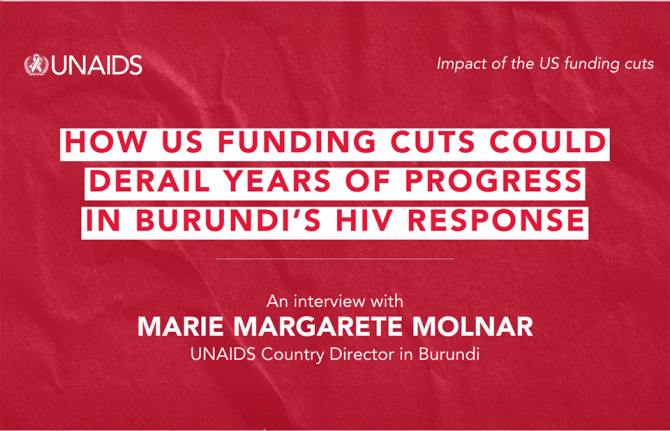
Feature Story
How US funding cuts could derail years of progress in Burundi’s HIV response
14 May 2025
14 May 2025 14 May 2025Q&A with UNAIDS Country Director in Burundi
International aid is shrinking, and countries are increasingly burdened by the need to prioritize debt repayment over essential services, including healthcare. This shift has left vulnerable populations more exposed, with the abrupt funding cuts by the United States throwing the HIV response in many countries into chaos. Burundi, unfortunately, is no exception. Across the country, HIV services have faced severe disruptions. Clinics are reducing their services, staff are being laid off, and thousands of people living with HIV are at risk of losing access to critical treatment.
In this interview, Marie Margarete Molnar, UNAIDS Country Director in Burundi, explains how communities are being affected, how the health system is coping, and what must happen next.
Q: Can you describe the current funding landscape for Burundi’s HIV response?
Burundi’s HIV response relies heavily on international aid - 95% of its funding comes from donors, with the US government contributing 51% through PEPFAR. This support sustained 10 major projects covering HIV prevention, treatment, and care for both the general population and vulnerable populations. PEPFAR also provided support to community-led monitoring projects and critical data system information.
Q: How have the recent US funding cuts affected these programmes?
Out of the 10 PEPFAR-funded projects, three were not eligible for the US waiver and had to stop operating. Some of the remaining seven, although eligible, could not resume their activities due to delays and financial uncertainty. As a result and based on an assessment conducted during the first month of the pause, at least 10 000 people living with HIV—who were among the 79 000 currently under treatment—have been directly affected. These individuals risk losing consistent access to medication and support services. In addition, 167 health professionals have lost their positions. These include doctors, nurses, psychologists, lab technicians, and community health workers—many of whom were directly providing HIV services. Financially, the immediate PEPFAR cut represents approximately US$ 6.5 million from the annual PEPFAR envelope of US$ 25 million for HIV in Burundi.
Q: What does this mean in practical terms for people on the ground?
Burundi had almost reached the 2025 ambitious targets: 95% of people living with HIV who know their HIV status, of whom 95% are on treatment and of the people on treatment 95% are virally suppressed. This was the result of strong collaboration between the government, civil society organizations and partners. The country was even recognized with an award. But now the third 95, on viral suppression, is declining because some people can no longer access viral load testing or follow-up services. If the situation continues, there is a high risk of an increase in new infections and a weakening of the entire HIV response system.
Q: What steps have the government and partners taken so far to respond to the crisis?
The government and partners acted quickly. UNAIDS conducted consultations during the first two weeks of February with key stakeholders. These consultations identified the scale of the impact and led to a series of recommendations that were shared with the Government and partners. The Ministry of Health together with UNAIDS and WHO held a two-day workshop with the PEPFAR implementing partners and civil society to understand how the cuts affected budgets, staffing, services, and beneficiaries and to brainstorm on rapid mitigation measures. As instances, it was recommended carrying out field missions to visit treatment sites and assess how services were coping without US support, forming a crisis response group and developing a national contingency plan. The government also began to identify treatment sites facing ARV shortages and organized a drug quantification workshop after PEPFAR-supported partners could no longer lead it.
Finalizing the HIV Sustainability Roadmap has also become a top priority. The roadmap is intended to guide how Burundi can finance and manage its HIV response without relying so heavily on external donors. We also discussed modeling different scenarios, from best case to worst case, based on whether funding returns or disappears entirely. These models would help us plan, reprioritize, and adapt strategies accordingly. We are also using the UNAIDS Rapid AIDS Financing Tool (RAFT) to get detailed data on how the funding cut is affecting commodities and staffing across the country.
Q: Is the government prepared to increase its contribution to its national HIV efforts?
It’s trying. Previously, funding for antiretroviral treatment was split between 76% from the Global Fund, 15% from the government, and 9% from PEPFAR. The government has now committed to covering partially that missing 9%. That shows political will. But it’s not just about medicine. It’s about health workers, community programmes and lab capacity. Burundi will need to restructure its approach by, for instance, integrating HIV into broader health and social protection systems, and significantly increase domestic health funding to reduce dependency, but this is difficult given the country's economic constraints.
Q: What’s your message to the international community?
Burundi is a fragile country facing multiple crises—economic instability, fuel shortages, emerging epidemics, and an influx of refugees from neighboring Democratic Republic of Congo. Despite these challenges, the country has made significant progress towards ending HIV, thanks to sustained investment in health including the HIV response. The risk now is losing these gains. Continued support from international partners is essential, not just for health but for the country’s overall development. At the same time, the Burundian government must increase its commitment to health funding. Only through global solidarity and strong political will can Burundi hope to end HIV by 2030.
The global community must understand that this is more than a budget line. It’s about lives, stability and global health security.
The Joint United Nations Programme on HIV/AIDS (UNAIDS) leads the global effort to end AIDS as a public health threat by 2030 as part of the Sustainable Development Goals.
Following the US stop work order in January, UNAIDS is working closely with governments and partners in affected countries to ensure that all people living with or affected by HIV continue to access life-saving services. For the latest updates, please visit unaids.org

